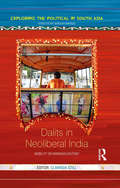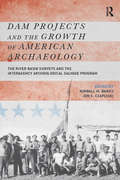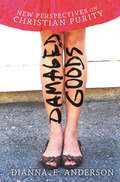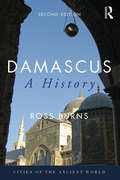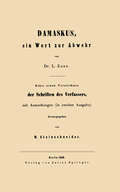- Table View
- List View
Dalit Women: Honour and Patriarchy in South India
by Clarinda StillOne of the only ethnographic studies of Dalit women, this book gives a rich account of individual Dalit women’s lives and documents a rise in patriarchy in the community. The author argues that as Dalits’ economic and political position improves, ‘honour’ becomes crucial to social status. One of the ways Dalits accrue honour is by altering patterns of women’s work, education and marriage, and by adopting dominant-caste gender practices. But Dalits are not simply becoming like upper castes; they are simultaneously asserting a distinct, politicised Dalit identity, formed in direct opposition to the dominant castes. They are developing their own ‘politics of culture’. Key to both, the author argues, is the ‘respectability’ of women. This has significant effects on gender equality in the Dalit community.
Dalit Women: Honour and Patriarchy in South India
by Clarinda StillOne of the only ethnographic studies of Dalit women, this book gives a rich account of individual Dalit women’s lives and documents a rise in patriarchy in the community. The author argues that as Dalits’ economic and political position improves, ‘honour’ becomes crucial to social status. One of the ways Dalits accrue honour is by altering patterns of women’s work, education and marriage, and by adopting dominant-caste gender practices. But Dalits are not simply becoming like upper castes; they are simultaneously asserting a distinct, politicised Dalit identity, formed in direct opposition to the dominant castes. They are developing their own ‘politics of culture’. Key to both, the author argues, is the ‘respectability’ of women. This has significant effects on gender equality in the Dalit community.
Dalit Women's Education in Modern India: Double Discrimination (Routledge Research on Gender in Asia Series)
by Shailaja PaikInspired by egalitarian doctrines, the Dalit communities in India have been fighting for basic human and civic rights since the middle of the nineteenth century. In this book, Shailaja Paik focuses on the struggle of Dalit women in one arena - the realm of formal education – and examines a range of interconnected social, cultural and political questions. What did education mean to women? How did changes in women’s education affect their views of themselves and their domestic work, public employment, marriage, sexuality, and childbearing and rearing? What does the dissonance between the rhetoric and practice of secular education tell us about the deeper historical entanglement with modernity as experienced by Dalit communities? Dalit Women's Education in Modern India is a social and cultural history that challenges the triumphant narrative of modern secular education to analyse the constellation of social, economic, political and historical circumstances that both opened and closed opportunities to many Dalits. By focusing on marginalised Dalit women in modern Maharashtra, who have rarely been at the centre of systematic historical enquiry, Paik breathes life into their ideas, expectations, potentials, fears and frustrations. Addressing two major blind spots in the historiography of India and of the women’s movement, she historicises Dalit women’s experiences and constructs them as historical agents. The book combines archival research with historical fieldwork, and centres on themes including slum life, urban middle classes, social and sexual labour, and family, marriage and children to provide a penetrating portrait of the actions and lives of Dalit women. Elegantly conceived and convincingly argued, Dalit Women's Education in Modern India will be invaluable to students of History, Caste Politics, Women and Gender Studies, Education Studies, Urban Studies and Asian studies.
Dalit Women's Education in Modern India: Double Discrimination (Routledge Research on Gender in Asia Series)
by Shailaja PaikInspired by egalitarian doctrines, the Dalit communities in India have been fighting for basic human and civic rights since the middle of the nineteenth century. In this book, Shailaja Paik focuses on the struggle of Dalit women in one arena - the realm of formal education – and examines a range of interconnected social, cultural and political questions. What did education mean to women? How did changes in women’s education affect their views of themselves and their domestic work, public employment, marriage, sexuality, and childbearing and rearing? What does the dissonance between the rhetoric and practice of secular education tell us about the deeper historical entanglement with modernity as experienced by Dalit communities? Dalit Women's Education in Modern India is a social and cultural history that challenges the triumphant narrative of modern secular education to analyse the constellation of social, economic, political and historical circumstances that both opened and closed opportunities to many Dalits. By focusing on marginalised Dalit women in modern Maharashtra, who have rarely been at the centre of systematic historical enquiry, Paik breathes life into their ideas, expectations, potentials, fears and frustrations. Addressing two major blind spots in the historiography of India and of the women’s movement, she historicises Dalit women’s experiences and constructs them as historical agents. The book combines archival research with historical fieldwork, and centres on themes including slum life, urban middle classes, social and sexual labour, and family, marriage and children to provide a penetrating portrait of the actions and lives of Dalit women. Elegantly conceived and convincingly argued, Dalit Women's Education in Modern India will be invaluable to students of History, Caste Politics, Women and Gender Studies, Education Studies, Urban Studies and Asian studies.
Dalits: Past, present and future
by Anand TeltumbdeThis book is a comprehensive introduction to dalits in India (who comprise over one-sixth of the country’s population) from the origins of caste system to the present day. Despite a plethora of provisions for affirmative action in the Indian Constitution, dalits are largely excluded from the mainstream except for a minuscule section. The book traces the multifarious changes that befell them during the colonial period and their development thereafter under the leadership of Babasaheb Ambedkar in the centre of political arena. It looks at hitherto unexplored aspects of the degeneration of the dalit movement during the post-Ambedkar period, as well as salient contemporary issues such as the rise of the Bahujan Samaj Party, dalit capitalism, the occupation of dalit discourse by NGOs, neoliberalism and its impact, and the various implicit or explicit emancipation schemas thrown up by them. The work also discusses ideology, strategy and tactics of the dalit movement; touches upon one of the most contentious issues of increasing divergence between the dalit and Marxist movements; and delineates the role of the state, both colonial and post-colonial, in shaping dalit politics in particular ways. A tour de force, this book brings to the fore many key contemporary concerns and will be of great interest to students, scholars and teachers of politics and political economy, sociology, history, social exclusion studies and the general reader.
Dalits: Past, Present and Future
by Anand TeltumbdeThis book is a comprehensive introduction to Dalits in India from their origin to the present day. Despite a plethora of provisions for affirmative action in the Indian Constitution, Dalits still suffer exclusion on various counts. The book traces the multifarious changes that befell them through history, germination of Dalit consciousness during the colonial period and its f lowering under the legendary leadership of Babasaheb Ambedkar. It provides critical insights to their degeneration during the post-Ambedkar period, taking stock of all significant developments therein such as the rise of the Bahujan Samaj Party, Dalit capitalism, NGOization of the Dalit discourse and the various implicit or explicit emancipation schemas thrown up by them. It also discusses ideology, implicit strategy and tactics of the Dalit movement, touches upon one of the most contentious issues of increasing divergence between the Dalit and Marxist movements, and delineates the role of the state, both colonial and post-colonial, in shaping Dalit politics in particular ways. This new edition includes a new chapter providing the causal analysis of the rise of Hindutva under Narendra Modi, its fascist march obliterating the idea of India sketched out by the Constitution, and forecasts its future as the Hindu Rashtra – the Brahmanic-fascist state – which has been the goal of its progenitors. A tour de force, this book brings to the fore many key contemporary concerns and will be of great interest to activists, students, scholars and teachers of politics, political economy, sociology, anthropology, history and social exclusion studies.
Dalits: Past, Present and Future
by Anand TeltumbdeThis book is a comprehensive introduction to Dalits in India from their origin to the present day. Despite a plethora of provisions for affirmative action in the Indian Constitution, Dalits still suffer exclusion on various counts. The book traces the multifarious changes that befell them through history, germination of Dalit consciousness during the colonial period and its f lowering under the legendary leadership of Babasaheb Ambedkar. It provides critical insights to their degeneration during the post-Ambedkar period, taking stock of all significant developments therein such as the rise of the Bahujan Samaj Party, Dalit capitalism, NGOization of the Dalit discourse and the various implicit or explicit emancipation schemas thrown up by them. It also discusses ideology, implicit strategy and tactics of the Dalit movement, touches upon one of the most contentious issues of increasing divergence between the Dalit and Marxist movements, and delineates the role of the state, both colonial and post-colonial, in shaping Dalit politics in particular ways. This new edition includes a new chapter providing the causal analysis of the rise of Hindutva under Narendra Modi, its fascist march obliterating the idea of India sketched out by the Constitution, and forecasts its future as the Hindu Rashtra – the Brahmanic-fascist state – which has been the goal of its progenitors. A tour de force, this book brings to the fore many key contemporary concerns and will be of great interest to activists, students, scholars and teachers of politics, political economy, sociology, anthropology, history and social exclusion studies.
Dalits: Past, present and future
by Anand TeltumbdeThis book is a comprehensive introduction to dalits in India (who comprise over one-sixth of the country’s population) from the origins of caste system to the present day. Despite a plethora of provisions for affirmative action in the Indian Constitution, dalits are largely excluded from the mainstream except for a minuscule section. The book traces the multifarious changes that befell them during the colonial period and their development thereafter under the leadership of Babasaheb Ambedkar in the centre of political arena. It looks at hitherto unexplored aspects of the degeneration of the dalit movement during the post-Ambedkar period, as well as salient contemporary issues such as the rise of the Bahujan Samaj Party, dalit capitalism, the occupation of dalit discourse by NGOs, neoliberalism and its impact, and the various implicit or explicit emancipation schemas thrown up by them. The work also discusses ideology, strategy and tactics of the dalit movement; touches upon one of the most contentious issues of increasing divergence between the dalit and Marxist movements; and delineates the role of the state, both colonial and post-colonial, in shaping dalit politics in particular ways. A tour de force, this book brings to the fore many key contemporary concerns and will be of great interest to students, scholars and teachers of politics and political economy, sociology, history, social exclusion studies and the general reader.
Dalits in Neoliberal India: Mobility or Marginalisation? (Exploring the Political in South Asia)
by Clarinda StillIndia’s economic growth has brought opportunities for many but to what extent has it benefitted its ethnically-shaped underclass: the Dalits? Have Dalits fared better in a neoliberal India or have structural economic and social changes served to magnify Dalit disadvantage? This volume offers a varied picture of Dalit experience in different states in contemporary India. The essays draw on factual research in rural and urban areas by experts in the field. With case studies ranging from Dalit entrepreneurs in Bhopal to housewives in Tamil Nadu to ex-millworkers in Mumbai, the book contends that radically progressive change and advance is attended by discrimination and exclusion, as well as surprising new areas of stigma. With contributions by political scientists, anthropologists, sociologists, and economists, the volume will be key reading for scholars and students of Dalit and subaltern studies, sociology, political science, and economics.
Dalits in Neoliberal India: Mobility or Marginalisation? (Exploring the Political in South Asia)
by Clarinda StillIndia’s economic growth has brought opportunities for many but to what extent has it benefitted its ethnically-shaped underclass: the Dalits? Have Dalits fared better in a neoliberal India or have structural economic and social changes served to magnify Dalit disadvantage? This volume offers a varied picture of Dalit experience in different states in contemporary India. The essays draw on factual research in rural and urban areas by experts in the field. With case studies ranging from Dalit entrepreneurs in Bhopal to housewives in Tamil Nadu to ex-millworkers in Mumbai, the book contends that radically progressive change and advance is attended by discrimination and exclusion, as well as surprising new areas of stigma. With contributions by political scientists, anthropologists, sociologists, and economists, the volume will be key reading for scholars and students of Dalit and subaltern studies, sociology, political science, and economics.
Dalits, Subalternity and Social Change in India (Routledge Contemporary South Asia Series)
by Ashok K. Pankaj Ajit K. PandeyThe linguistic origin of the term Dalit is Marathi, and pre-dates the militant-intellectual Dalit Panthers movement of the 1970s. It was not in popular use till the last quarter of the 20th century, the origin of the term Dalit, although in the 1930s, it was used as Marathi-Hindi translation of the word "Depressed Classes". The changing nature of caste and Dalits has become a topic of increasing interest in India. This edited book is a collection of originally written chapters by eminent experts on the experiences of Dalits in India. It examines who constitute Dalits and engages with the mainstream subaltern perspective that treats Dalits as a political and economic category, a class phenomenon, and subsumes homogeneity of the entire Dalit population. This book argues that the socio-cultural deprivations of Dalits are their primary deprivations, characterized by heterogeneity of their experiences. It asserts that Dalits have a common urge to liberate from the oppressive and exploitative social arrangement which has been the guiding force of Dalit movement. This book has analysed this movement through three phases: the reformative, the transformative and the confrontationist. An exploration of dynamic relations between subalternity, exclusion and social change, the book will be of interest to academics in the field of sociology, political science and contemporary India.
Dalits, Subalternity and Social Change in India (Routledge Contemporary South Asia Series)
by Ashok K. Pankaj Ajit K. PandeyThe linguistic origin of the term Dalit is Marathi, and pre-dates the militant-intellectual Dalit Panthers movement of the 1970s. It was not in popular use till the last quarter of the 20th century, the origin of the term Dalit, although in the 1930s, it was used as Marathi-Hindi translation of the word "Depressed Classes". The changing nature of caste and Dalits has become a topic of increasing interest in India. This edited book is a collection of originally written chapters by eminent experts on the experiences of Dalits in India. It examines who constitute Dalits and engages with the mainstream subaltern perspective that treats Dalits as a political and economic category, a class phenomenon, and subsumes homogeneity of the entire Dalit population. This book argues that the socio-cultural deprivations of Dalits are their primary deprivations, characterized by heterogeneity of their experiences. It asserts that Dalits have a common urge to liberate from the oppressive and exploitative social arrangement which has been the guiding force of Dalit movement. This book has analysed this movement through three phases: the reformative, the transformative and the confrontationist. An exploration of dynamic relations between subalternity, exclusion and social change, the book will be of interest to academics in the field of sociology, political science and contemporary India.
Dam Projects and the Growth of American Archaeology: The River Basin Surveys and the Interagency Archeological Salvage Program
by Kimball M. Banks Jon S. CzaplickiThe Smithsonian Institution’s River Basin Surveys and the Interagency Archeological Salvage Program were the most ambitious archaeological projects ever undertaken in the United States. Administered by the National Park Service from 1945–1969, the programs had profound effects—methodological, theoretical, and historical—on American archaeology, many of which are still being felt today. They stimulated the public’s interest in heritage preservation, led to the passage of the National Historic Preservation Act, served as the model for rescue archaeology in other countries, and helped launch the “New Archaeology.” This book examines the impacts of these two programs on the development of American archaeology.
Dam Projects and the Growth of American Archaeology: The River Basin Surveys and the Interagency Archeological Salvage Program
by Kimball M. Banks Jon S. CzaplickiThe Smithsonian Institution’s River Basin Surveys and the Interagency Archeological Salvage Program were the most ambitious archaeological projects ever undertaken in the United States. Administered by the National Park Service from 1945–1969, the programs had profound effects—methodological, theoretical, and historical—on American archaeology, many of which are still being felt today. They stimulated the public’s interest in heritage preservation, led to the passage of the National Historic Preservation Act, served as the model for rescue archaeology in other countries, and helped launch the “New Archaeology.” This book examines the impacts of these two programs on the development of American archaeology.
The Damage Done: Twelve Years Of Hell In A Bangkok Prison
by W FellowsThink about the most wretched day of your life. Maybe it was when someone you loved died, or when you were badly hurt in an accident, or a day when you were so terrified you could scarcely bear it. No imagine 4,000 of those days in one big chunk. In 1978, Warren Fellows was convicted in Thailand of heroin trafficking and was sentenced to life imprisonment. The Damage Done is his story of an unthinkable nightmare in a place where sewer rats and cockroaches are the only nutritious food, and where the worst punishment is the khun deo - solitary confinement, Thai style. Fellows was certainly guilty of his crime, but he endured and survived human-rights abuses beyond imagination. This is not his plea for forgiveness, nor his denial of guilt; it is the story of an ordeal that no one would wish on their worst enemy. It is an essential read: heartbreaking, fascinating and impossible to put down.
Damaged: The Heartbreaking True Story Of A Forgotten Child
by Cathy GlassThe No. 1 Sunday Times Bestseller.
Damaged Goods: New Perspectives on Christian Purity
by Dianna AndersonDianna Anderson offers a fresh approach to the purity conversation, one that opens a new dialogue with the most influential Christian authors of her generation. Anderson's new sexual ethics draw on core biblical principles and set a standard for today's Christians that may be as influential Joshua Harris' I Kissed Dating Goodbye, Don Raunikar's Choosing God's Best, and Elisabeth Elliot's Passion and Purity. Anderson uses her own illuminating experience with the purity movement to: Reach out to women and men trying to reconcile their own sexuality with their understanding of "what God wants," cultural stigma, and media pressuresDemonstrate how Christian ideas about purity have infiltrated American politics and culture-and why women are losingOffer an affirmative, healing path for everyone to understand their sexuality: one that reconciles scripture, culture, and common sense Provocative and engaging, she will revolutionize the way you think about sex, abstinence, politics, and faith.
Damaged Goods: New Perspectives on Christian Purity
by Dianna AndersonDianna Anderson offers a fresh approach to the purity conversation, one that opens a new dialogue with the most influential Christian authors of her generation.Anderson's new sexual ethics draw on core biblical principles and set a standard for today's Christians that may be as influential Joshua Harris' I Kissed Dating Goodbye, Don Raunikar's Choosing God's Best, and Elisabeth Elliot's Passion and Purity. Anderson uses her own illuminating experience with the purity movement to: Reach out to women and men trying to reconcile their own sexuality with their understanding of "what God wants," cultural stigma, and media pressuresDemonstrate how Christian ideas about purity have infiltrated American politics and culture-and why women are losingOffer an affirmative, healing path for everyone to understand their sexuality: one that reconciles scripture, culture, and common sense.Provocative and engaging, she will revolutionize the way you think about sex, abstinence, politics, and faith.
Damascus: A History (Cities of the Ancient World)
by Ross BurnsDamascus, first published in 2005, was the first account in English of the history of the city, bringing out the crucial role it has played at many points in the region’s past. It traces the story of this colourful, significant and complex city through its physical development, from the its emergence in around 7000 BC through the changing cavalcade of Aramaean, Persian, Greek, Roman, Byzantine, Arab, Turkish and French rulers to independence in 1946. This new edition has been thoroughly updated using recent scholarship and includes an additional chapter placing the events of the Syrian post-2011 conflict in the context of the city’s tumultuous experiences over the last century. This volume is a must-read for anyone interested in the sweep of Syrian history and archaeology, and is an ideal partner to Burns’ Aleppo (2016). Lavishly illustrated, Damascus: A History remains a unique and compelling exploration of this fascinating city.
Damascus: A History (Cities of the Ancient World)
by Ross BurnsDamascus, first published in 2005, was the first account in English of the history of the city, bringing out the crucial role it has played at many points in the region’s past. It traces the story of this colourful, significant and complex city through its physical development, from the its emergence in around 7000 BC through the changing cavalcade of Aramaean, Persian, Greek, Roman, Byzantine, Arab, Turkish and French rulers to independence in 1946. This new edition has been thoroughly updated using recent scholarship and includes an additional chapter placing the events of the Syrian post-2011 conflict in the context of the city’s tumultuous experiences over the last century. This volume is a must-read for anyone interested in the sweep of Syrian history and archaeology, and is an ideal partner to Burns’ Aleppo (2016). Lavishly illustrated, Damascus: A History remains a unique and compelling exploration of this fascinating city.
A Dame Full of Vim and Vigour
by OgilvieFirst Published in 1999. Routledge is an imprint of Taylor & Francis, an informa company.
A Dame Full of Vim and Vigour
by OgilvieFirst Published in 1999. Routledge is an imprint of Taylor & Francis, an informa company.
Dame Kathleen Kenyon: Digging Up the Holy Land (UCL Institute of Archaeology Publications)
by Miriam C DavisDame Kathleen Kenyon has always been a larger-than-life figure, likely the most influential woman archaeologist of the 20th century. In the first full-length biography of Kenyon, Miriam Davis recounts not only her many achievements in the field but also her personal side, known to very few of her contemporaries. Her public side is a catalog of major successes: discovering the oldest city at Jericho with its amazing collection of plastered skulls; untangling the archaeological complexities of ancient Jerusalem and identifying the original City of David; participating in the discipline’s most famous all-woman excavation at Great Zimbabwe. Her development (with Sir Mortimer Wheeler) of stratigraphic trenching methods has been universally emulated by archaeologists for over half a century. Her private life—her childhood as daughter of the director of the British Museum, her accidental choice of a career in archaeology, her working at bombed sites in London during the blitz, and her solitary retirement to Wales—are generally unknown. Davis provides a balanced and illuminating picture of both the public Dame Kenyon and the private person.
Dame Kathleen Kenyon: Digging Up the Holy Land (UCL Institute of Archaeology Publications)
by Miriam C DavisDame Kathleen Kenyon has always been a larger-than-life figure, likely the most influential woman archaeologist of the 20th century. In the first full-length biography of Kenyon, Miriam Davis recounts not only her many achievements in the field but also her personal side, known to very few of her contemporaries. Her public side is a catalog of major successes: discovering the oldest city at Jericho with its amazing collection of plastered skulls; untangling the archaeological complexities of ancient Jerusalem and identifying the original City of David; participating in the discipline’s most famous all-woman excavation at Great Zimbabwe. Her development (with Sir Mortimer Wheeler) of stratigraphic trenching methods has been universally emulated by archaeologists for over half a century. Her private life—her childhood as daughter of the director of the British Museum, her accidental choice of a career in archaeology, her working at bombed sites in London during the blitz, and her solitary retirement to Wales—are generally unknown. Davis provides a balanced and illuminating picture of both the public Dame Kenyon and the private person.




